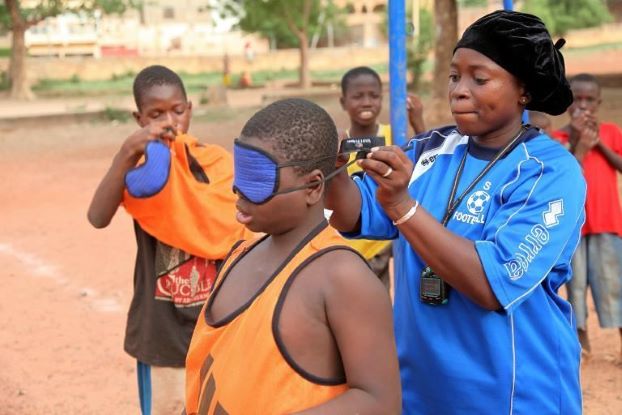
In a classroom at a school for the blind in Mali’s capital Bamako, pupils quietly follow a French lesson taught in braille but it is clear they are impatient to get outside to play football.
On the school grounds is a dusty red dirt pitch where three times a week, they chase a special ball containing a bell in a version of football for the blind.
“It’s my passion,” said Mamadou Thiam, 18, who has been playing this game for two years. “My ambition is to play in the big international competitions.”
A version of five-a-side, the fast-moving game is known in Mali by its French name “cecifoot” (from “cecite” meaning blindness) and follows the rules of the International Federation of Association Football (FIFA), with a few modifications.
Along with the ball, which makes a noise as it is booted around, there are guides on the sidelines, shouting instructions to help the players find the way to their team’s goalpost. The pitch is surrounded by protective barriers.
Everyone, apart from the sighted goalkeeper, wears eye masks, so that the blind and partially-sighted are all on the same level.
And enthusiasm for the sport among Malian boys starts young. Daouda Kassambara, only eight years old, wants to play in the big games one day and says the sport motivates him to work hard at school.
Cecifoot “makes me want to go further (in my studies), so the day will come when I will be a great player, why not even an international player?” he said.
Beyond the physical effort, experts say the game helps young people to build their confidence and independence, skills they will need for everyday life off the pitch.
Mariam Katito teaches physical education at a Bamako high school but spends her free time training the blind players.
“I have loved these children since they were tiny, and I have always loved giving them whatever I can,” she said after a training session.
Alamissa Cisse, a teacher at the Institute for Blind Youth (IJA), says that playing football teaches the students “how to master the ball, the space around them, and above all teaches them communication”.
“For example, with each movement, or contact with the ball, players should shout ‘voy’ (Spanish for “I go”) so as not to crash into each other,” said Cisse, who is himself blind.
– Paralympic discipline –
First played in Spain in the 1920s, 5-a-side football for the blind and visually impaired made its debut at the Athens Paralympics in 2004.
In London at the 2012 Games, teams from Argentina, Brazil, Europe, Iran and China competed in the final eight, but none from Africa.
On a football-loving continent, only two countries have a national 5-a-side team for the blind, Cameroon and Morocco, and there is no African championship.
Mali is working on forming its own adult 5-a-side team, many of them former IJA students. Some recently travelled to learn from their counterparts in France, which took the silver medal at the London Paralympics.
They made a good impression at the matches outside the French capital, winning two games against the Parisian club, AVH, that plays in the French 5-a-side league.
Back in Bamako, Cedric Kante, a professional footballer currently playing in the French second division, invited some of his fellow French and Malian sighted players to a friendly match against the Malian 5-a-side team.
Donning masks, they took part in the game without being able to see the goalpost, the ball, or their teammates.
It wasn’t easy, Kante admitted.
“It was quite complicated, to start with, but I am sure one can get better,” he said, adding that there are “synergies” to be found with the sighted game.
One of his French teammates, Simon Pouplin, was full of praise for the Malian team.
“I tip my hat to them. When you see what they are able to do, you almost forget that they can’t see. With hearing alone, they are able to do some very impressive things,” he said.
